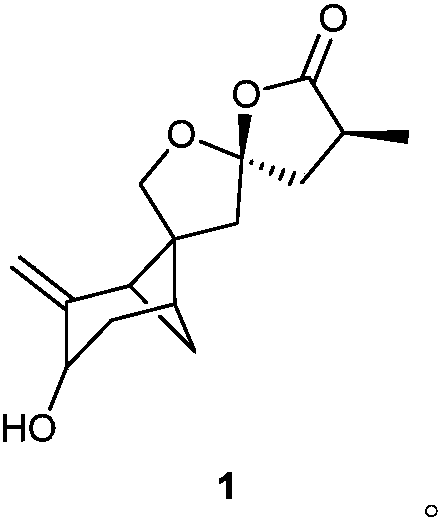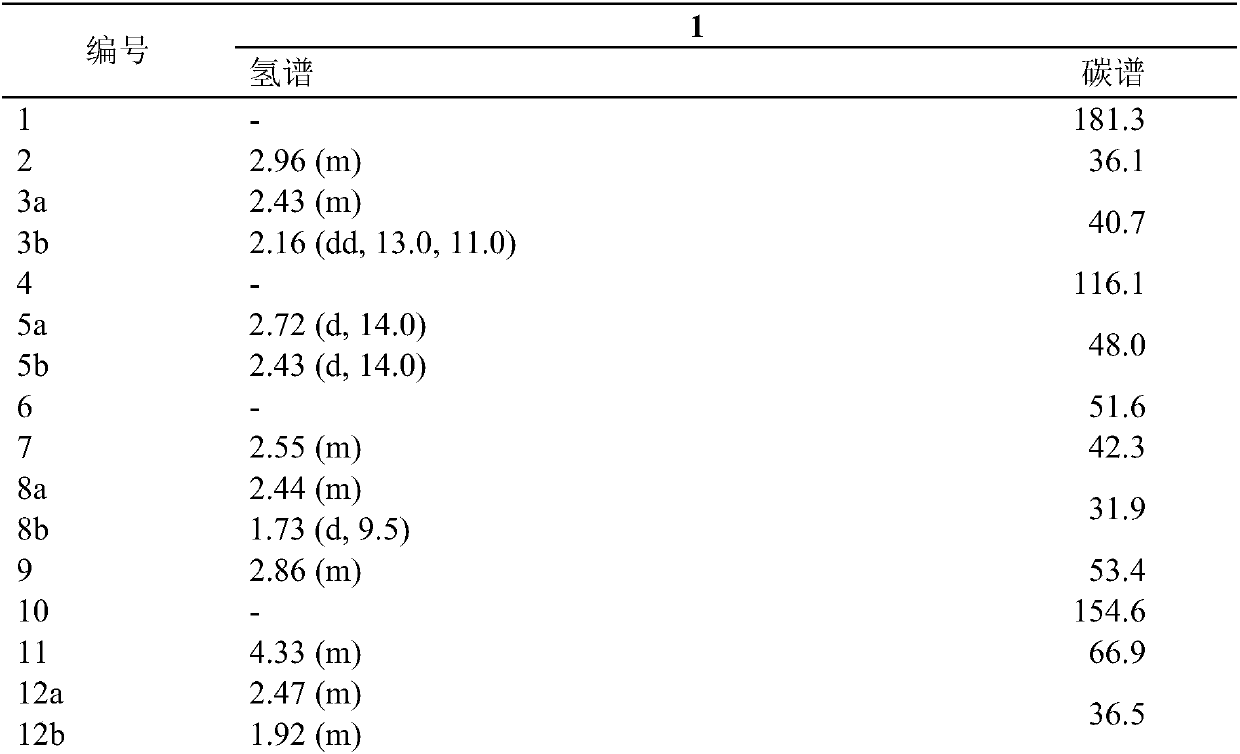A kind of sesquiterpene compound and its preparation and application
A sesquiterpene and compound technology, applied in the field of α-glucosidase inhibitors, can solve the problems of weak activity and high adverse reaction rate, and achieve the effect of small molecular weight and low dosage
- Summary
- Abstract
- Description
- Claims
- Application Information
AI Technical Summary
Problems solved by technology
Method used
Image
Examples
Embodiment 1
[0020] The preparation method of embodiment 1 compound 1
[0021] 1. Preparation of Penicillium extensa ferment by fermentation culture
[0022] 1) Strain: Penicillium expansum, purchased from China Agricultural Microorganism Culture Collection and Management Center, the strain number is 1511C0001ACCC37275.
[0023] 2) Cultivation and storage on slant
[0024] Solid medium: glucose 3g, potato extract powder 0.5g, KH 2 PO 4 0.2g, 1.5g agar, add water to 100mL, pH value is natural.
[0025] Solid culture method: Penicillium expanses strains are inoculated on a solid medium slant, and cultivated at 28°C for 5-7 days. After the solid culture is over, place the slant at 4-10°C and refrigerate for later use. Preparation of 30% glycerol cryovials: Under aseptic conditions, wash the slant of the test tube with 6ml of sterilized 30% glycerin, dispense into glycerol tubes (3ml / branch), and store at -20°C for later use.
[0026] 3) Shake flask seed culture
[0027] Medium: glucose...
Embodiment 2
[0044] Physicochemical properties and spectral data of embodiment 2 compound 1
[0045] Compound 1: white amorphous powder; molecular formula is C 15 h 20 o 4 ;Optical rotation [α] -36.7 (c0.15, MeOH); infrared v max 3441,2923,2583,1745,1649,1462,1356,1266,1208,1144,1064,996,923,883,848,762,722,690cm -1 ; Hydrogen spectrum and carbon spectrum are shown in Table 1; High resolution mass spectrum (ESI) m / z: 265.1426[M+H] + .
[0046] Table 1 NMR data of compound 1
[0047]
[0048]
Embodiment 3
[0049] The α-glucosidase inhibitory activity of embodiment 3 compound 1
[0050] 25 μL, 0.085U / mL α-glucosidase potassium phosphate buffer solution (pH 6.8) and 100 μL potassium phosphate buffer solution (pH 6.8) containing different concentrations (0.48, 0.24, 0.12, 0.06, 0.03mg / mL) of compound 1 Add it into a 96-well plate, mix well, (add 80 μL 1.0M Na 2 CO 3 aqueous solution to terminate the reaction), and incubated at 37°C for 15min. Add 25 μL of 5.0 mM 4-nitrophenol-β-D-glucopyranoside (pNPG) potassium phosphate buffer, incubate at 37°C for 30 min, then add 80 μL of 1.0M Na 2 CO 3 The aqueous solution terminates the reaction, reads the absorbance value at 405nm and calculates the inhibition rate with a microplate reader, and the inhibition rate=1-(A 测定 -A 测定背景 ) / (A 空白 -A 空白背景 ), where, A 测定背景 is the absorbance of the system when the sample to be tested is added but no enzymatic reaction occurs, A 空白背景 is the absorbance of the system when the sample to be tested i...
PUM
 Login to View More
Login to View More Abstract
Description
Claims
Application Information
 Login to View More
Login to View More - Generate Ideas
- Intellectual Property
- Life Sciences
- Materials
- Tech Scout
- Unparalleled Data Quality
- Higher Quality Content
- 60% Fewer Hallucinations
Browse by: Latest US Patents, China's latest patents, Technical Efficacy Thesaurus, Application Domain, Technology Topic, Popular Technical Reports.
© 2025 PatSnap. All rights reserved.Legal|Privacy policy|Modern Slavery Act Transparency Statement|Sitemap|About US| Contact US: help@patsnap.com



